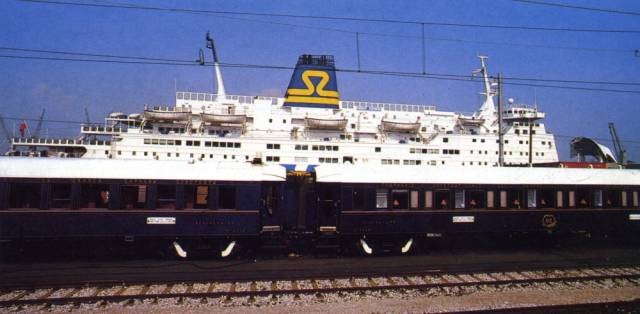#OrientExpress – Orient Express is a name that conjures the famous romantic long-distance luxury train service across Europe in which was set the detective novel by Agatha Christie and where there is also a railway related connection with the Irish Sea, writes Jehan Ashmore.
The novel ‘Murder on the Orient Express’ featuring the Belgian detective Hercule Poirot, was set during the era from one of three Orient Express services of the 1930’s, the Simplon Orient Express service: Calais-Paris-Lausanne-Milan-Venice-Belgrade-Athens/Istanbul. A remake of the classic film is currently on the silver screen, notably in the recently reopened and restored art deco Stella Theatre cinema, Rathmines, Dublin. The star-studded film is directed by Belfast born Kenneth Branagh who also plays Poirot.
The present day service is the Venice Simplon-Orient-Express (VSOE) operated by Belmond Ltd using beautifully-restored 1920s, 30s & 50s coaches, providing a 5-star luxury train experience between London, Paris, Verona & Venice, running from March up to this month of November. Belmond also operate hotels, river-cruises and in Ireland the Grand Hibernian that began this luxury rail service only last year.
The journey on the VSOE from London to Venice takes 24 hours and actually involves two trains, a historic British Pullman train from the UK capital to Folkestone, then guests are conveyed by coach on the Eurotunnel shuttle of the Channel Tunnel to Calais. From the French ferryport they alight the classic elegant sleeping-cars and dining carriages to Venice.
Before the opening of the Channel Tunnel in 1994, guests of the VSOE took the ferry from Folkestone to Boulogne. Both the luxury rail and sea route were then operated by Sea Containers whose ferry subsidiary Sealink British Ferries, had conveyed VSOE guests across the Strait of Dover.
Sister car ferries Hengist and Horsa during extensive refits in 1986 had installed the Venice Simplon Orient Express (VSOE) Lounge bar in the style similar to the British Pullman and were a unique feature on an English Channel ferry. It was also unique on the Irish Sea when Horsa served a stint on the Dun Laoghaire-Holyhead service in 1990 as a summer support ship to routine ferry St. Columba. At that time, however, Horsa had just been acquired by Swedish ferry giant, Stena which marketed the former SBF services as Sealink Stena Line that ultimately was renamed Stena Line.
An opportunity was taken to make a foot passenger day round trip from Dun Laoghaire on board Horsa to experience the VSOE lounge which was open despite not running such rail-sea connected sailings. Even during English Channel service, the vast majority of non-VSOE sailings saw the lounge open albeit to motorists-only. Such passengers were provided with specially issued tickets in order to gain access to what when recalled on the Irish Sea a rather dark wood panelled lounge to echo the rail-era.
As part of the Sea Containers/ Sealink British Ferries ownership of the VSOE, guests having arrived in Venice transferred to the ferry/cruiseship Orient Express on a route among calls that included Piraeus before finally reaching Istanbul. The 12,000grt car ferry / cruiseship sea-service (1986-1990) had an added novel element in the overall VSOE experience by transiting through the Corinth Canal. The ship had an adapted livery of SBF in that the words ‘Orient Express’ was painted on the hull.
As alluded another SBF ferry, Hengist also carried out VSOE related sailings that is on the English Channel, though the ferry made headline news during the Great Storm of 1987. The hurricane-strength winds hit particularly southern England (exactly 30 years ago to the day) of this year’s Storm Ophelia striking Ireland.
The ferry without passengers had been berthed in Folkestone, however the mooring lines under the severe strain of the storm were constantly snapping, this led to the decision to depart the Kent harbour and ride out the storm offshore. Having been forced to go to sea, giant waves caused the loss of all electrical power with Hengist drifting helplessly onto The Warren. A beach located near the harbour, where the stranded ferry made for one of the most iconic images of the Great Storm.
Hengist remained impaled on part of the concrete sea defences for almost a week before re-floating took place. Initially, the damaged ferry was towed to Dover but was eventually repaired in drydock in Tilbury downriver of London on the Thames Estuary.
The Folkestone-Boulogne route was closed at the end of 1991 with the advent of the Channel Tunnel opening three years later. Thus concentrating the vast majority of traffic to take services out of the Port of Dover or indeed take the new tunnel linking between the UK and France.
A third and final English Channel sister, Senlac had served on the Newhaven-Dieppe. This route as part of the extensive Sealink/ British Rail network (incl. SNCF), saw all three sisters deployed on Irish Sea routes to cover drydocking of routine ships and other relief duties. The UK-France service is currently marketed as Transmanche Ferries but is operated by DFDS.































































